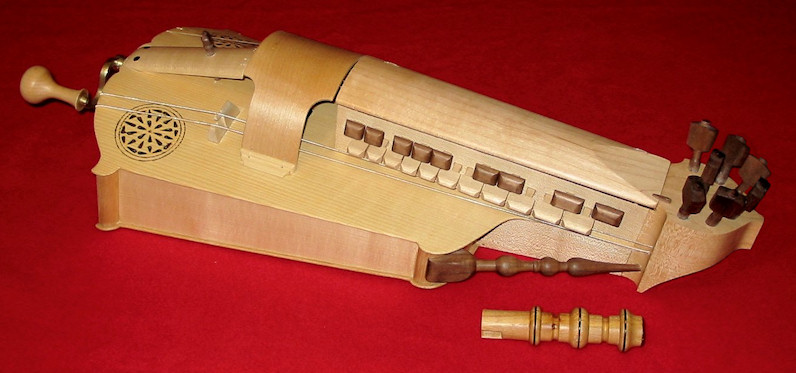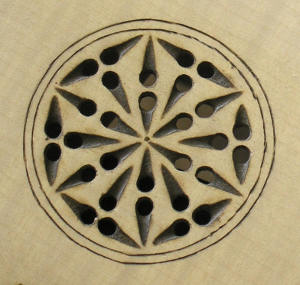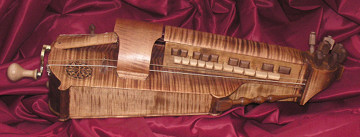 |
Royal College Hurdy-gurdy |

Royal College Hurdy-gurdy
This hurdy-gurdy is based on a late 16th or early 17th century example in the instrument collection of the Royal College of Music, London. My working plans are derived from an exhaustive set of measurements I took a few years ago. Hurdy-gurdies of this type were common throughout most of the 16th century and the first half of the 17th. They were also revived at the French courts in the 18th century as "rustic" instruments. A similar instrument in the Victoria and Albert Museum was overhauled in about 1750, with the addition of much ivory and ebony. 
Original in the Royal College Collection

Front View

Back View
The Royal College model has two chanterelles, mouche, trompette, tenor and bass bourdons, and, unusually, a fifth drone running through the pegbox, between the chanterelles. This can be set up in a number of ways - e.g. as a unison with the mouche or trompette, as a high drone, or tuned to an alternative note to facilitate quick key chages. There is a built-in storage compartment between the head and the front block, accessed from the underside. This is very useful for storing the tuning peg, cotton, spare strings, and any other small accessories. The tone is satisfying and rounded, not too loud, but it is incisive enough to play for dancing, and blends excellently with a renaissance guitar. 
Soundhole - simple but effective pyrography

"Aged" finish
Sound ClipsC tuning
G tuning
G tuning, no trompette, keybox drone in g
Prices
To order or enquire, pleasecontact me Cases - Excellent cases can be ordered from specialist manufacturers such as Kingham MTM, but they're pricy. I can supply an attractive, custom-built plywood case, black with chrome fittings, for £220 when ordered with an instrument. Delivery - the price depends on where you live. Please enquire. I hate it when websites say "Phone for a quote", so to give you some idea - getting a baroque guitar in its case to America, including insurance, is currently about £170. Getting one to Kent is about half that. Waiting time, from placing an order to clutching your new baby, is currently about 16 months. It's very approximate, because the schedule often contains items that are somewhat experimental, and they may take more or less time to complete than anticipated. Usually more. Deposit- I usually ask for £150 (non-returnable unless I'm dead, insane, incapacitated or incarcerated) to secure an order and cover materials. Once that's paid, your order is entered into my Magic Book. Nothing happens for several months, then you receive an email to tell you I've started construction. A few weeks later, a big parcel arrives, and you squeal with delight.
Anote on HUMIDITY - delicate wooden instruments are remarkably resilient, but
they can have major problems with both high and low atmospheric humidity levels. I keep my workshop at the
recommended humidity level, between 45% and 50%, and I strongly recommend that instruments are kept as close
to that range as possible. Electronic humidity meters are available cheaply on the Internet. They're small enough
to keep in your instrument's case. |
 More Instruments |
 Diabolus Homepage |
 Email for Diabolus |